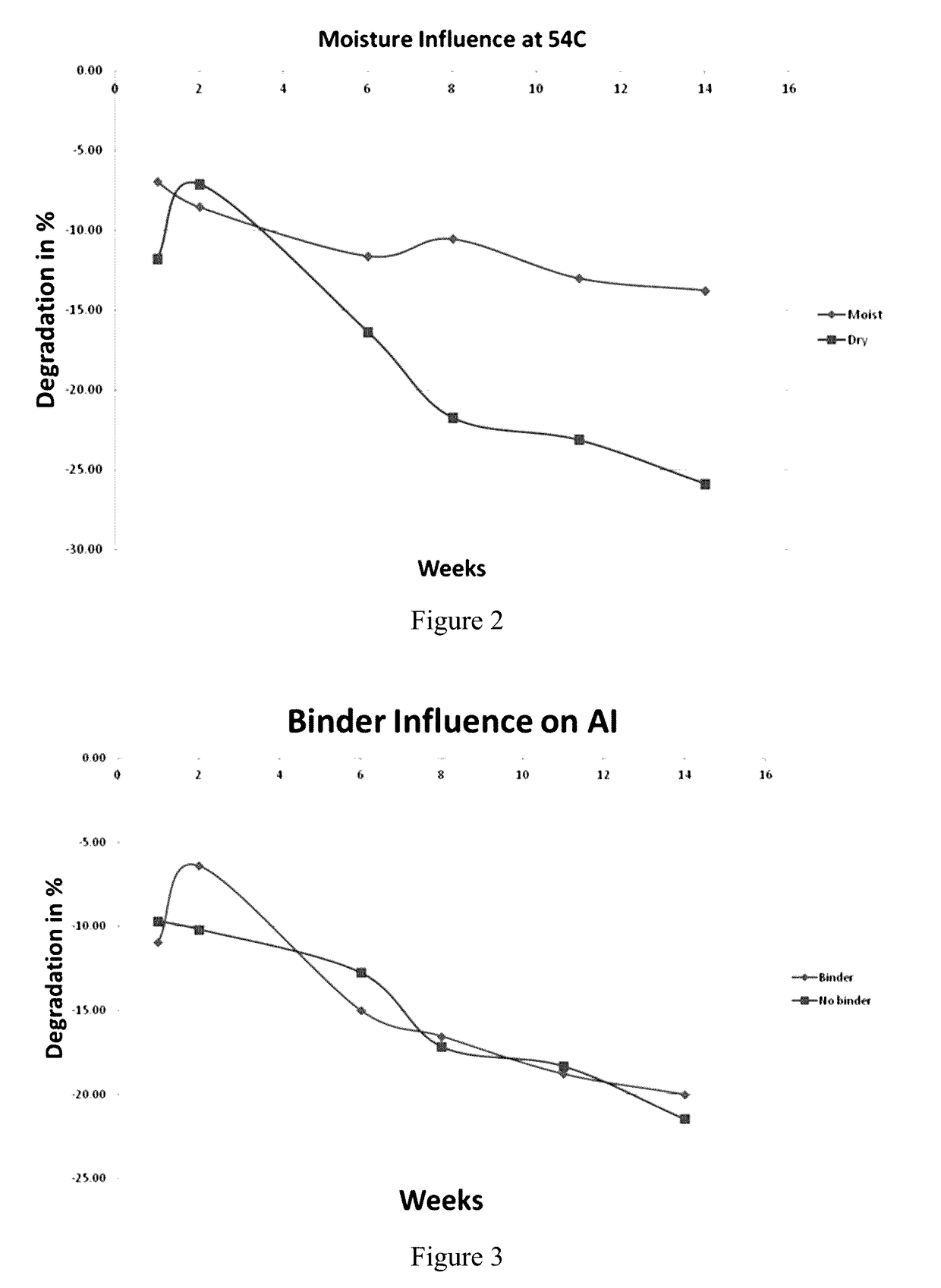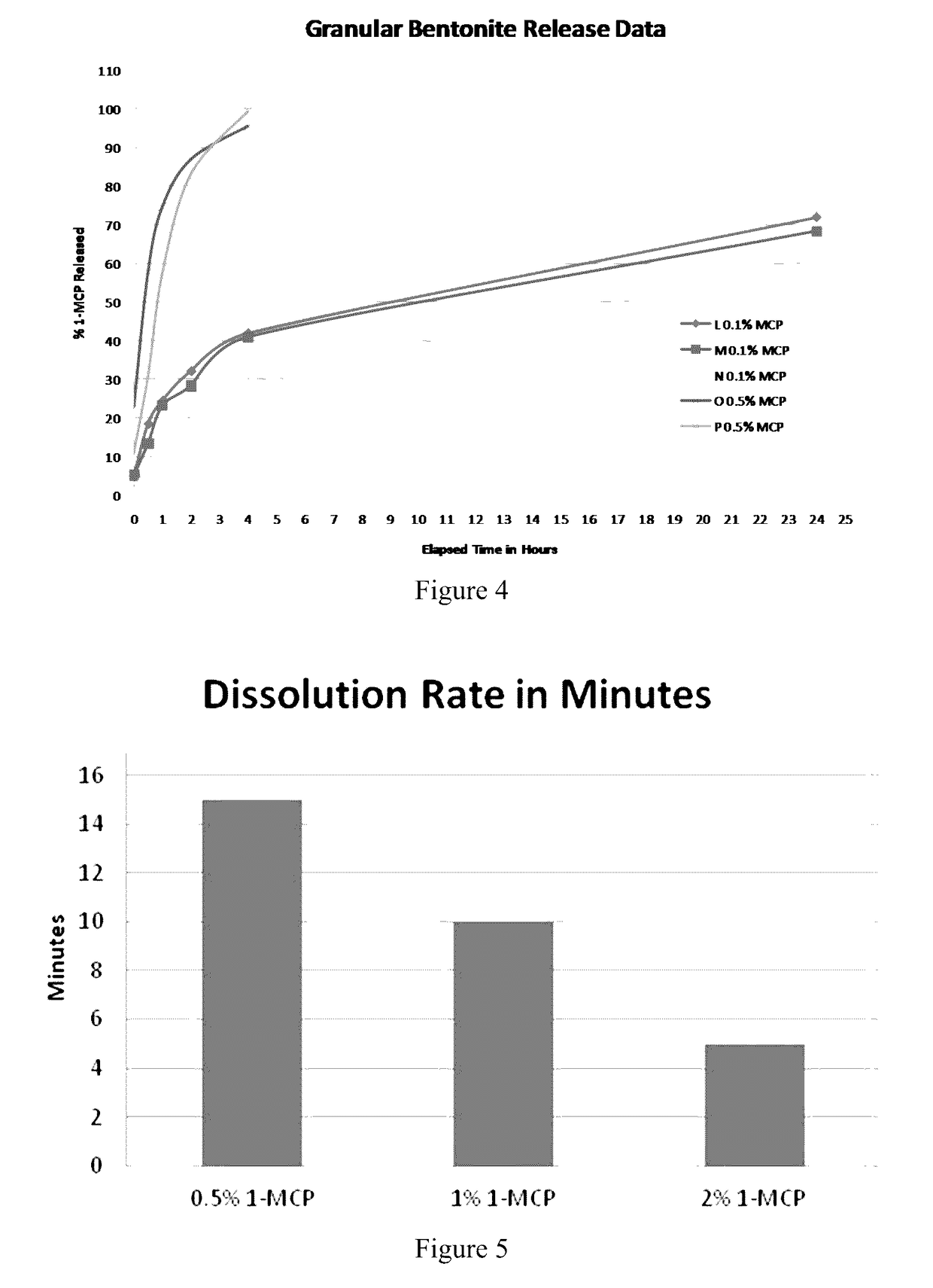Methods and compositions of granule formulations
a technology of granules and compositions, applied in the field of methods and compositions of granule formulations, can solve problems such as hazards, and achieve the effects of improving the chemical stability of the molecular complex
- Summary
- Abstract
- Description
- Claims
- Application Information
AI Technical Summary
Benefits of technology
Problems solved by technology
Method used
Image
Examples
example 1
Stability of 1-MCP in the Presence of Carriers
[0118]To obtain good field coverage, the granule formulations are increased in bulk by dilution with at least one inert carrier. Carriers are tested using a roller compactor in the presence of 0.1% 1-MCP equivalent of HAIP (High Active Ingredient Particles; a powder of 1-MCP complexed with alpha-cyclodextrin). The blend (before compaction) as well as both the 1st pass and recycled materials are analyzed for chemical stability.
TABLE 1Active ingredient evolution in the presence of solid diluents (after compaction)% loss after % change from RT Carriersone week at RTafter at 54° C.Limestone68Ammonium Sulfate205Sodium Bentonite23Urea15100Ammonium 5050Sulfate GranularMono Ammonium 2020SulfatePotash (with iron)1000
[0119]All carriers are pre-dried overnight at 65 (or 150° F.) with a residual moisture level close or below 0.5% except for bentonite. The post oven drying moisture in bentonite averages about 2.61%. For clarity, only data from the re...
example 2
Additional Carriers
[0120]Three different types of clays are tested in this Example: sodium, calcium and activated bentonite clays.
TABLE 2Stability and moisture levels for additional carriersChangeOneChangeTwoChangesMoisturevs.week atvs.weeks atvs.Carrierlevel %Ambienttheoretical54° C.ambient54° C.ambientRegular8.40.4234−5.92%0.4179−1.30%0.4192−0.99%VolclayVolclay0.660.4371−2.88%0.4325−1.04%0.4175−4.48%dried at120° C.Calcinated0.090.4469−0.68%0.4.48−9.42%0.1768−60.44%GypsumCaSO40.370.45340.75%0.4443−2.01%0.3007−33.68%KCL0.140.3298−26.71%0.3016−8.55%0.3200−2.97%K2SO40.220.3949−12.24%0.0618−84.35%N.A.N.A.NaCl (1)0.160.2647−41.18%0.2598−1.85%N.A.N.A.NaCl (2)0.040.45420.93%0.3775−16.88%N.A.N.A.B20011.040.4325−3.89%0.43510.60%0.3709−14.24%Pure-Dent9.160.4333−3.71%0.44562.84%0.3667−15.37%B810Spress9.110.4171−7.31%0.4108−1.51%0.3366−19.30%B820Note:NaCl (1) contains cotnmercial table salt; NaCl (2) purchased from Aldrich.
[0121]All clays have an initial relatively high level of moisture (rang...
example 3
Release Rate
[0125]Approximately 600 mg of a sample containing 0.1% 1-MCP and 120 mg of a sample containing 0.5% 1-MCP are added to a 250 ml glass bottle. Next, 5 ml of Milli Q water is added and the bottle capped. The bottles are swirled slightly to wet the sample and start the release. Sampling is carried out every hour for 4 hours without further shaking or swirling the sample. After twenty-four hours the sample is swirled for 30 minutes on the rotator to release any remaining 1-MCP gas and then analyzed again.
[0126]Results are shown in FIG. 4, where bentonite samples containing 0.5% 1-MCP (Samples O and P) induce release of 1-MCP gas much faster than the samples having only 0.1% 1-MCP (Samples L, M, and N). Water penetration happens by swelling the clay upon contact. Bentonite sodium clay can swell 8 to 10 times its weight when wetted. The data suggest that the samples with more clay and less 1-MCP have a slower release rate, In the 0.5% 1-MCP sample, HAIP is much quicker in cont...
PUM
 Login to View More
Login to View More Abstract
Description
Claims
Application Information
 Login to View More
Login to View More - R&D
- Intellectual Property
- Life Sciences
- Materials
- Tech Scout
- Unparalleled Data Quality
- Higher Quality Content
- 60% Fewer Hallucinations
Browse by: Latest US Patents, China's latest patents, Technical Efficacy Thesaurus, Application Domain, Technology Topic, Popular Technical Reports.
© 2025 PatSnap. All rights reserved.Legal|Privacy policy|Modern Slavery Act Transparency Statement|Sitemap|About US| Contact US: help@patsnap.com



